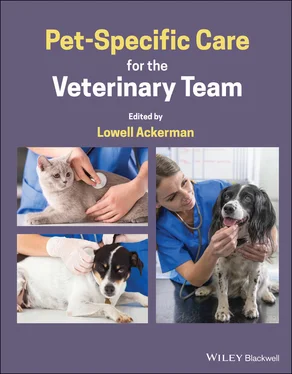In other cases, even though chronic problems are by their very definition “chronic,” there can be much larger cycles that can explain observed changes from placebo. For example, with atopic dermatitis, pets may be worst during peak pollination periods for specific allergens. During the worst periods of such pollination, owners are more likely to be desperate for new treatment alternatives. However, intense pollination periods tend to be relatively short‐lived, so in some instances the allergen load may actually have diminished significantly on its own and the clinical benefits should really be attributed to this discontinuation of intense pollination. Just because a pet gets better on a therapy does not mean that the primary effect can be attributed to the medication.
One very interesting aspect of placebo studies is that sometimes they can still provide benefits even if the patient/client knows they are administering placebos. This is known as the honest placebo effect. Thus, human researchers for several years have been conducting open‐label placebo studies where patients know they are receiving placebo, and still documenting benefit. We know that for some clients, there is an expectation that they will receive at least some sort of medication for whatever problem their pet might have. In fact, even some veterinarians might feel the need to dispense something for a client in need, even if there is not a specific medical indication. For example, sometimes clients request antibiotics for a pet when it is sick, even if there is no indication of bacterial involvement. Sometimes owners (and veterinarians) just want to feel like they are doing “something,” and a percentage will report success with this “something.”
The nocebo effect is an interesting phenomenon in which people have negative expectations about something and that alone is enough to make them perceive an ill effect. This may account in part for people who believe that certain vaccines have deleterious effects or that certain foods are more responsible for allergies and insensitivities than would otherwise be statistically reasonable. Adverse effects to food and vaccines certainly exist and are well documented in animals, but many more people harbor beliefs about potential adverse effects than can be justified by scientific likelihood.
 EXAMPLES
EXAMPLES
Mrs Jansen brought Meili, her 2‐year‐old spayed female shih tzu, to ABC Animal Hospital for persistent scratching, especially around her face and ears. Mrs Jansen seemed to think the problem was most likely due to a food allergy, since the problem started a few weeks after a new commercial diet was introduced and she noticed that the diet included gluten, which she herself was avoiding.
In consultation with the veterinary team, Mrs Jensen agreed to commence an elimination diet trial for a minimum of eight weeks, and if there was any question of effect, she was willing to continue for a total of 12 weeks. She was given the option of either a commercial hypoallergenic diet or a home‐made recipe with novel ingredients, and she thought she would have better control with the home‐made diet. An allergy medication was dispensed to be used for the first two weeks of the trial just to give Meili some relief, and then would be discontinued for the remainder of the dietary trial.
Meili was presented eight weeks later and was substantially improved. Mrs Jansen was happy that she was able to stick to the home‐made diet, even though it was more work that she was doing in addition to food preparation for her other family members. She also lamented why pet food companies were able to sell foods with such ingredients that were capable of making pets sick.
Dr Green congratulated Mrs Jansen on her ability to persevere for the entire dietary trial, but had one other request just to conclusively determine a cause‐and‐effect relationship. He didn't want Mrs Jansen to have to cook for Meili forever, or to try diet after diet to find an acceptable commercial option, so he asked if she would be prepared to try one other scientific trial – reintroduce the original diet to see how long it took for the clinical signs to start to recur. After all, if the problem was really the diet, they should be able to induce the clinical signs with reintroduction of the offending allergen(s), and then make them quickly go away again by stopping the diet once again. Once they had conclusively established the diet as the culprit, they would commence challenge feeding to determine which ingredient(s) were actually problematic.
Mrs Jansen was a bit unsure of the process, and didn't want Meili to suffer, but she agreed to the trial realizing that she could reverse any ill effects quickly, and that it would appease Dr Green's scientific curiosity so they could get on with more permanent solutions. However, with challenge feeding, Mrs Jansen was surprised that Meili did not get worse when she reintroduced the original diet, even after she had fed it for a full two weeks. She even fed Meili some bread and pasta, the gluten content of which she was sure would aggravate Meili's condition … but it didn't. Dr Green explained that the likelihood was that Meili was allergic to certain pollens which were prevalent during the period when she was symptomatic, and perhaps food was not playing a major role after all. He praised Mrs Jansen for her willingness to explore the complexity of Meili's condition, provided her with information on atopic dermatitis, and asked her to track Meili's clinical signs on a calendar and if major problems recurred, they would have some documentation to compare with allergy test results to determine the most likely allergens implicated.
 TAKE‐AWAYS
TAKE‐AWAYS
Don't be fooled – the placebo effect is evident in animals.
Caregivers are responsible for judging the impact of interventions on clinical issues and their impressions can be influenced.
Simply enrolling in a study or taking part in a therapeutic trial can influence the perception of benefit. This is known as the Hawthorne effect.
Most chronic conditions tend to wax and wane over time, and sometimes medication benefits can be attributed to times when clinical signs would be waning regardless.
People can be influenced to expect that certain interventions are likely to have bad effects, even if not likely. This is known as the nocebo effect.
 MISCELLANEOUS
MISCELLANEOUS
Recommended Reading
1 Conzemius, M.G. and Evans, R.B. (2012). Caregiver placebo effect for dogs with lameness from osteoarthritis. J. Am. Vet. Med. Assoc. 241 (10): 1314–1319.
2 Gruen, M.E., Dorman, D.C., and Lascelles, B.D.X. (2017). Caregiver placebo effect in analgesic clinical trials for cats with naturally occurring degenerative joint disease‐associated pain. Vet. Rec. 180 (19): 473.
3 McKenzie, B. (2018). What is a placebo? Animals receiving inert treatments may show improvement due to causes other than direct placebo effects. http://veterinarypracticenews.com/what‐is‐a‐placebo
4 McKenzie, B.A. (2019). Placebos for Pets? The Truth about Alternative Medicine in Animals. England: Ockham Publishing, Newmachar, Scotland.
Читать дальше

 EXAMPLES
EXAMPLES TAKE‐AWAYS
TAKE‐AWAYS MISCELLANEOUS
MISCELLANEOUS










